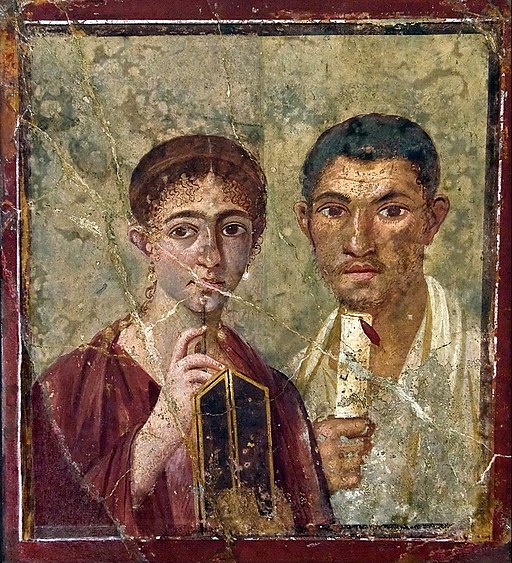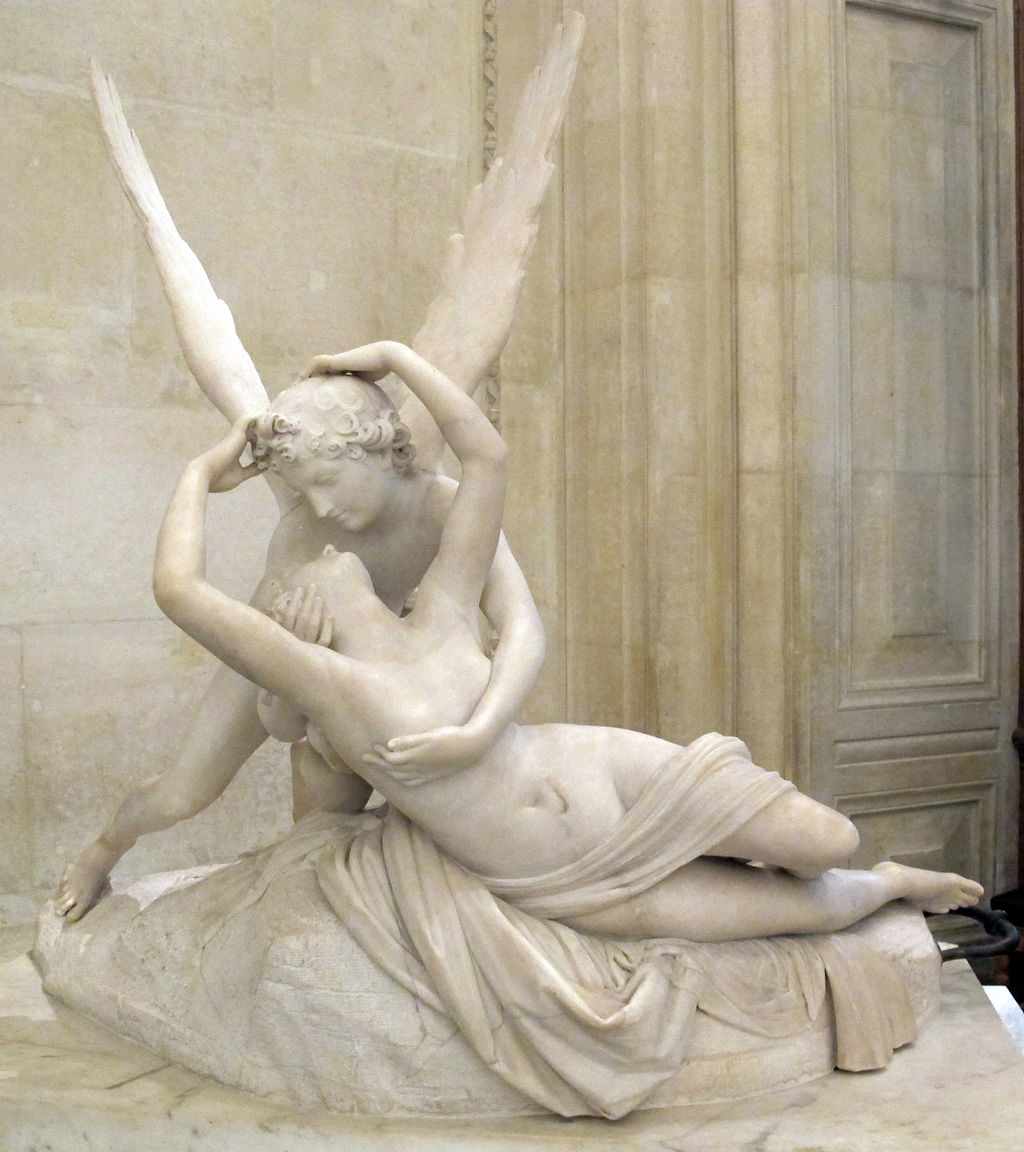
Pompeii was an ancient city located near Naples in Italy. It was buried under 4 to 6 m (13 to 20 ft) of volcanic ash and pumice in the eruption of Mount Vesuvius in AD 79. The city was preserved under the ash, and the excavated city has provided a unique snapshot of Roman life, frozen at the moment it was buried.
Some of the most exciting art and artifacts discovered in Pompeii are the Frescos uncovered on the walls of the many villas that were buried. Some of the significant Pompeii Frescos that are preserved at the National Archaeological Museum, Naples include:
- Portrait of Terentius Neo and his Wife
- Theatre Couple from Pompeii
Portrait of Terentius Neo and his Wife
The Portrait of Terentius Neo is a famous and exquisite fresco that was found in Pompeii in the House of Terentius Neo. It is considered one of the most delicate pieces of art from the area of Vesuvius. The Fresco depicts a pair of middle-class Pompeians believed to be man and wife.
An inscription was found on the outside of the house to recommend the name Terentius Neo. He was a baker as the house had been modified to include a bakery, and the portrait shows the couple as equal members of a confident and fashionable merchant class. The man wears a toga, which is the mark of a Roman citizen. He holds a rotulus, suggesting he is also involved in public events. The woman is in the foreground and holds a stylus and wax tablet, emphasizing that she is of equal status, educated and literate.
The fact that the portrait shows imperfections or unique features in the faces is rare and makes the subjects real and brings their characters to life. The Fresco was discovered in 1868 and is exhibited in the National Archaeological Museum of Naples in Naples.
Rotulus
The man in this Fresco is holding a rotulus, which is a roll consisting of a long and narrow strip of writing material, historically papyrus or parchment. It was wound around a wooden rod with writing on its interior side such that it is unwound vertically so that the writing runs parallel to the rod. Citizens historically used rotuli for legal records.
Wax Tablet and Stylus
The woman is holding a wax tablet that is made of wood and covered with a layer of wax. It has a cover for the tablet, in the form of a “double-leaved” diptych. It was used as a reusable and portable writing surface in Antiquity.
Writing on the wax surface was performed with a pointed instrument, called a stylus. A straight-edged spatula-like implement with the stylus tip. The modern expression of “a clean slate” equates to the Latin phrase “tabula rasa.”
Wax tablets were used for a variety of purposes, from taking down notes to recording business accounts.
Terentius Neo and his Wife – Fresco
- Artifact: Terentius Neo and his Wife
- Year: 20-30 AD
- Discovered: 1868
- Medium: Fresco
- Dimensions: Height: 58 cm (22.8″)
- Museum: National Archaeological Museum, Naples
~~~
Theatre Couple from Pompeii – Fresco

This Roman Fresco from Pompeii dates from the 1st century AD and depicts a man in a theatre mask and a woman wearing a garland while playing the lyre.
The lyre is a string instrument known for its use in classical Antiquity. The lyre is similar in appearance to a small harp but with distinct differences. The lyre of classical Antiquity was played by being strummed with a pick, like a guitar rather than being plucked as with a harp.
In the 2nd century BC, Pompeii enriched itself by taking part in Rome’s conquest of the east. These riches enabled Pompeii to boom and expand. The forum and many buildings were built, including a range of theatres.
The new buildings included the amphitheater built in 70 BC and the Odeon constructed in 80 BC. These buildings raised the status of Pompeii as a cultural center. The extensive range of places for entertainment significantly enhanced the economic development of the city. The city became a famous passage for goods that arrived by sea and had to be sent toward Rome or Southern Italy along the nearby Appian Way.
Theatre Area of Pompeii
The theatre area of Pompeii is located in the southwest region of the city. Three principal buildings made up this area: the Large Theatre, the Odeon or small theatre, and the Quadriporticum. These buildings served as an entertainment and meeting center of the city. Pompeii had two stone theatres of its own nearly two decades before the first permanent stone theatre was erected in Rome in the 50s BCE.
Odeon
The Odeon was a smaller roofed theatre or “Theatrum tectum,” that sat 1,500 spectators built in 80 BC. The theatre follows the plan of other Roman theatres and odeon structures. Where the Large Theatre was used primarily for staging drama, the Odeon was intended for a more educated audience, as well as a musical concert performance.
Pompeii’s Large Theatre
The Large Theatre was built into a natural hill in the second century BC. This theatre sat roughly 5,000 spectators and is one of the original permanent stone theatres to stand in Rome.
Designed in the Greek style, the tiered seating extends from the orchestra carved out of the hillside. The upper class was separated from the other seating by a short wall, this was to reinforce the class system, and the divide within the social standings of the classes in Roman society.
Theatre Couple from Pompeii – Fresco
- Artifact: Theatre Couple from Pompeii Fresco
- Year: 1st century AD
- Medium: Fresco
- Museum: National Archaeological Museum, Naples
Fresco
Fresco is a technique of mural painting executed on wet lime plaster. Water is used as the vehicle for the dry-powder pigment to merge with the plaster so that the art becomes an integral part of the wall.
The word Fresco is derived from the Italian adjective fresco meaning “fresh.” The fresco technique has been employed since Antiquity.
Frescoes were painted in ancient Greece, but few of these works have survived. Some of the best-preserved Roman frescos come from the ruins of Pompeii and Herculaneum.
A Virtual Tour of the National Archaeological Museum, Naples
- The Alexander Mosaic from Pompeii
- The Farnese Hercules
- Venus Callipyge
- Frescos from Pompeii
A Virtual Tour of Museums in Italy
Rome Museums and Historical Sites
- The Vatican Museums
- Capitoline Museums
- St. Peter’s Basilica
- National Roman Museum
- Galleria Borghese
Florence Museums
- Uffizi Gallery
- Accademy’s Gallery
- Palazzo Pitti
Milan Museums
- Santa Maria Delle Grazie
- Sforza Castle Museums
- Brera Art Gallery, Pinacoteca di Brera
- Museo Poldi Pezzoli
Bologna Museums
- The Archaeological Civic Museum (MCA) of Bologna
- Sanctuary of Santa Maria della Vita
Venice Museums
- Gallerie dell’Accademia
Naples Museums
- National Archaeological Museum, Naples
~~~
“In the darkness, you could hear the crying of women, the wailing of infants, and the shouting of men. Some prayed for help. Others wished for death. But still more imagined that there were no Gods left and that the universe was plunged into eternal darkness.”
– Pliny the Younger
~~~
Photo Credit: 1) Berthold Werner / Public domain
Popular this Week








 Sponsor your Favorite Page
Sponsor your Favorite Page SEARCH Search for: Search Follow UsJoin – The JOM Membership Program
Sponsor a Masterpiece with YOUR NAME CHOICE for $5
Share this:
- Tweet
